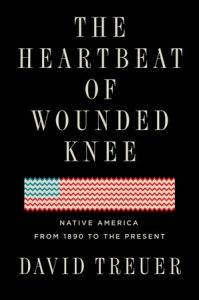Professor Coll Thrush (UBC)
International Co-Investigator, ‘Beyond the Spectacle’
The ‘Beyond the Spectacle’ team are often asked about where members of the public and scholars new to these topics might go to learn more about Indigenous history. To that end, we’ve compiled a short list of some of the best recent work on Native histories in what are currently known as Canada and the United States. All authored by Indigenous scholars, these books place Native voices front and centre and connect the past with the present – and future.

The genocidal conflict known as King Philip’s War, which raged across New England in the 1670s, remains a foundational element of the United States’ colonial history. While the conflagration has received treatment by numerous scholars over the years, Abenaki literary scholar and historian Lisa Brooks’ Our Beloved Kin: A New History of King Philip’s War (Yale, 2018) tells the story from a completely new angle, focusing on the experiences and perspectives of Indigenous people such as Weetamoo, a Wampanoag headwoman, and James Printer, a Nipmuc scholar at Harvard College. Recently honoured with the prestigious Bancroft Prize, the top award in American history, Our Beloved Kin draws on deep archival research, a profound understanding of the land, and even forays into fiction to tell stories that have up to this point been largely invisible in histories of New England.

Just as King Philip’s War has often been (wrongly) framed as the end of Indigenous history in New England, the devastating massacre of hundreds of Lakota civilians at Wounded Knee in 1890 has all too often been portrayed as the death knell of Native resistance in the United States. This false narrative is roundly dismissed in The Heartbeat of Wounded Knee: Native America from 1890 to the Present by Ojibwe writer David Treuer (Riverhead, 2019), which has exploded onto numerous bestseller lists in recent months. Described by The New York Times Review of Books as “an informed, moving, and kaleidoscopic portrait,” Treuer’s immensely readable account of Indigenous life and politics in the US since the late nineteenth century shatters powerful myths that locate “real” Native people in the past.

For those who don’t follow news from “Indian country,” the anti-pipeline protests at Standing Rock, South Dakota in 2016 and 2017 might have seemed to come out of nowhere, but the truth is that the land and water protectors who gathered there, with their powerful slogan “Mni Wiconi: Water Is Life,” were part of an unbroken tradition of Native organizing and resistance. Two new books – Our History is the Future: Standing Rock Versus the Dakota Access Pipeline, and the Long Tradition of Indigenous Resistance by Lower Brule Sioux American Studies scholar Nick Estes (Verso, 2019) and As Long as Grass Grows: The Indigenous Fight for Environmental Justice, from Colonization to Standing Rock by Colville Confederated Tribes member and journalist Dina Gilio-Whitaker (Beacon, 2019) – will help readers understand how events like Standing Rock, which are far from over, fit into broader historical contexts. Together, they offer rich, nuanced, and forceful counternarratives to imagined Indigenous defeat and disappearance, while also offering agendas for the future.

On the Canadian side of the colonially-enforced border, Native scholars have also been front and centre in refiguring history from Indigenous perspectives. Mohawk historian Susan Hill’s masterful The Clay We Are Made Of: Haudenosaunee Land Tenure on the Grand River (Manitoba, 2017) tells the story of the Six Nations from their own perspective, grounding relations to territory and to human and non-human kin through institutions such as the Great Law of Peace. The Haudenosaunee, also known as the Iroquois Confederacy, have one of the longest traditions of diplomacy with and travel to Britain, going back to at least 1710, and so this book will be of particular interest to readers in the United Kingdom.

Meanwhile, Michi Saagiig Nishnaabeg activist and scholar Leanne Betasamosake Simpson, one of the most influential Indigenous voices in North America, makes an assertive historical argument through the very title of her recent book As We Have Always Done: Indigenous Freedom through Radical Resistance (Minnesota, 2017). Like Estes and Gilio-Whitaker above, Simpson sets present-day Native politics within a longer history of resistance; in her case, however, that history is grounded specifically in Nishnaabeg relationships to self, community, and territory. Simpson’s discussions of gender are especially central to her argument, and while the book is written for an Indigenous audience, non-Native readers will also gain much from As We Have Always Done.

Lastly, we want to highlight a book that, as of this writing, has not yet been released. In 2015, renowned writer and activist Roxanne Dunbar-Ortiz released An Indigenous Peoples’ History of the United States (Beacon), which won the American Book Award and galvanized readers across America. In late 2019, Beacon will release Dunbar-Ortiz’s follow-up book, An Indigenous Peoples’ History of the United States for Young People, adapted by non-Indigenous scholar Jean Mendoza and Debbie Reese (Nambe Pueblo), the leading expert on representations of Native people in children’s literature. While we have yet to see it, we expect it to deftly and critically explore the ways in which settler colonialism continues into the present, just as Native resistance and survivance continue as well. Books about Indigenous peoples for younger readers can be notoriously problematic, so we are eager to add this to our ever-expanding reading list of important works by Native and allied scholars.
In the months ahead, watch the ‘Beyond the Spectacle’ blog for more “further reading” lists!


For another Indigenous perspective from within Canadian colonial borders, I would recommend “We Share our Matters: Two Centuries of Writing and Resistance at Six Nations of the Grand River” by Rick Monture of McMaster University. https://uofmpress.ca/books/detail/we-share-our-matters